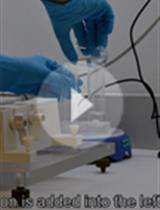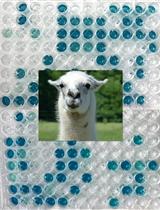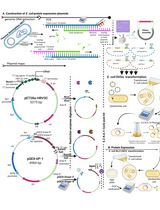- EN - English
- CN - 中文
Purification of Native Dentilisin Complex from Treponema denticola by Preparative Continuous Polyacrylamide Gel Electrophoresis and Functional Analysis by Gelatin Zymography
通过制备连续聚丙烯酰胺凝胶电泳和凝胶酶谱分析法纯化来自梭状龋齿螺旋体的天然Dentilisin复合物及其功能分析
发布: 2024年04月05日第14卷第7期 DOI: 10.21769/BioProtoc.4970 浏览次数: 1282
评审: Kristin L. ShinglerEmmanuel Orta-ZavalzaAna Martinez

相关实验方案

从蓝藻集胞藻sp. PCC 6803中分离类囊体膜并利用CN-PAGE非变性聚丙烯酰胺凝胶电泳分析光合色素蛋白复合物
Josef Komenda [...] Tomas Zakar
2019年01月05日 7560 阅读
Abstract
Periodontal disease is characterized by the destruction of the hard and soft tissues comprising the periodontium. This destruction translates to a degradation of the extracellular matrices (ECM), mediated by bacterial proteases, host-derived matrix metalloproteinases (MMPs), and other proteases released by host tissues and immune cells. Bacterial pathogens interact with host tissue, triggering adverse cellular functions, including a heightened immune response, tissue destruction, and tissue migration. The oral spirochete Treponema denticola is highly associated with periodontal disease. Dentilisin, a T. denticola outer membrane protein complex, contributes to the chronic activation of pro-MMP-2 in periodontal ligament (PDL) cells and triggers increased expression levels of activators and effectors of active MMP-2 in PDL cells. Despite these advances, no mechanism for dentilisin-induced MMP-2 activation or PDL cytopathic behaviors leading to disease is known. Here, we describe a method for purification of large amounts of the dentilisin protease complex from T. denticola and demonstrate its ability to activate MMP-2, a key regulator of periodontal tissue homeostasis. The T. denticola dentilisin and MMP-2 activation model presented here may provide new insights into the dentilisin protein and identify potential therapeutic targets for further research.
Key features
• This protocol builds upon a method described by Cunningham et al. [1] for selective release of Treponema outer membrane proteins.
• We adapted the protocol for the purification of biologically active, detergent-stable outer membrane protein complexes from large batch cultures of T. denticola.
• The protocol involves large-scale preparative electrophoresis using a Model 491 Prep Cell.
• We then use gelatin zymography to demonstrate the activity of the purified dentilisin complex by its ability to activate matrix metalloproteinase 2 (MMP-2).
Keywords: Treponema denticola (梭状龋齿螺旋体)Background
Periodontitis is a chronic inflammatory disease resulting from bacterial dysbiosis and unfavorable host–bacterial interactions. This ultimately leads to the destruction of periodontal tissues. The development of dysbiotic oral biofilms is associated with the emergence of periodontal disease. This condition is often attributed to elevated levels of the "red complex" bacteria, which include Treponema denticola, Porphyromonas gingivalis, and Tannerella forsythia [2], while several other periodontopathogenic species have been identified in recent studies [3–5]. Previous studies using 16S rRNA and shotgun sequencing have established notable dissimilarities in the microbial communities of individuals with good oral health vs. those with periodontitis. Periodontitis is a complex condition that is not solely caused by one type of microbe. Instead, it is thought to be influenced by various factors, such as changes in inflammation and interactions between the host and microbes, particularly when keystone pathogens colonize [6]. Also, it is important to highlight that various factors play crucial roles in the development of periodontitis, as they can either support or hinder the equilibrium of oral microorganisms.
In this study, we focused on the contribution of the most well-known and well-characterized periodontal pathogenic oral spirochete, namely T. denticola, which is highly associated with periodontal disease. However, T. denticola is often below detectable levels in healthy gingival plaque [7,8]. T. denticola, the most readily cultivable oral spirochete, is the model organism for studying spirochete–host interactions in periodontitis. The severity of periodontitis is directly linked to an increase in the colonization levels of T. denticola, highlighting its significant contribution to the disease [9,10]. One of the factors contributing to the virulence of T. denticola is its protease complex called dentilisin. Dentilisin is an outer membrane–associated complex consisting of the acylated subtilisin-family PrtP protease and two other lipoproteins (PrcB and PrcA) that are unique to oral spirochetes (reviewed in [11]). Dentilisin is encoded as an operon in the chromosome consisting of prcB-prcA-prtP. Dentilisin proteolytic activity directly affects host cells and tissue: it disrupts intercellular junctions [12], contributes to tissue penetration [13], specifically cleaves host proteins critical to maintaining tissue homeostasis [14], and induces dysregulation of TLR/MyD88 and integrin/FAK signaling mechanisms [15–17]. The multifaceted action of T. denticola dentilisin not only facilitates T. denticola's adhesion to and harm of epithelial cells and fibroblasts but also aids in penetrating epithelial tissue; furthermore, it may be involved in T. denticola's strategies to evade complement-mediated bactericidal activity [12,18–20]. One of the unique features of the dentilisin complex is that it retains its stability and proteolytic activity when unheated samples are subjected to SDS-PAGE. We and others have exploited this feature by using electrophoretic methods to purify dentilisin and characterize its activity [14,21,22]. We have previously reported the use of preparative continuous polyacrylamide gel electrophoresis (PC-PAGE) to purify several T. denticola outer membrane–associated proteins [20,22–24]. Here, we describe a method for purifying large amounts of the active dentilisin complex using this method.
The present study focuses on exploring the link between dentilisin and MMP-2 activation in relation to periodontitis. Here, we describe a methodology for the purification of substantial amounts of the dentilisin protease complex from T. denticola and demonstrate its capacity to activate MMP-2, a key regulator of periodontal tissue homeostasis. We present the protocols used in this study in three sections: I. Detergent extraction of T. denticola outer membrane components; II. PC-PAGE for purification of T. denticola dentilisin; and III. Gelatin zymography to detect activation of MMP-2 by dentilisin.
Part I: Detergent extraction of T. denticola outer membrane components
Materials and reagents
Biological materials
Treponema denticola MHE strain [25]. This strain (derived from T. denticola ATCC 35405) is an isogenic mutant that lacks Msp, a prominent outer membrane protein. We used T. denticola MHE for the present study because it is difficult to separate dentilisin from Msp using the wild-type ATCC 35405 strain [20,24]. This strain is available from the authors upon request. While the mutation carried in T. denticola MHE was selected by resistance to erythromycin, antibiotic pressure is not required to maintain the mutation.
Reagents
Tryptone (Fisher Scientific, catalog number: 211705)
Brain heart infusion (Fisher Scientific, catalog number: 237500)
Yeast extract (Fisher Scientific, catalog number: 611805000)
Gelatin (Bio-Rad Laboratories, catalog number: 1706537)
(NH4)2SO4 (Thermo Scientific, catalog number: OXCM0635B)
MgSO4·7H2O (Thermo Scientific, catalog number: AAA144910I)
K2HPO4 (Fisher Scientific, catalog number: BP363)
KH2PO4 (Fisher Scientific, catalog number: BP362)
NaCl (Fisher Scientific, catalog number: S271)
KOH (Fisher Scientific, catalog number: P250)
KCl (Fisher Scientific, catalog number: BP366)
Na2HPO4 (Sigma Millipore, catalog number: 567547)
MgCl2 (Fisher Scientific, catalog number: BP214)
Thiamine pyrophosphate (TPP) (Sigma-Aldrich, catalog number: C8754)
Glucose (Sigma-Aldrich, catalog number: G5400)
L-cysteine HCl (Fisher Scientific, catalog number: BP376)
Sodium pyruvate (Fisher Scientific, catalog number: BP356)
Glacial acetic acid (Fisher Scientific, catalog number: A38S)
Propionic acid (Sigma-Aldrich, catalog number: P1386)
N-butyric acid (Sigma-Aldrich, catalog number: B10355-0)
N-valeric acid (Sigma-Aldrich, catalog number: V9759)
Isobutyric acid (Sigma-Aldrich, catalog number: I1754)
Isovaleric acid (Sigma-Aldrich, catalog number: 12954-2)
D,L-methylbutyric acid (Sigma-Aldrich, catalog number: 193070)
Rabbit serum*, heat inactivated (Pel Freeze Biologicals, catalog number: 31127)
Triton X-114 (Anapoe-X-114) (Anatrace, catalog number: APX114)
Acetone (Fisher Scientific, catalog number: A18)
Tris base (Fisher Scientific, catalog number: BP152)
HCl (12.1 N) (Fisher Scientific, catalog number: A144)
1 M Tris pH 6.8 (Fisher Scientific, catalog number: BP152)
DTT (Fisher Scientific, catalog number: BP172)
SDS (Fisher Scientific, catalog number: BP166)
Glycerol (Fisher Scientific, catalog number: BP229)
Bromophenol blue (BPB) (Fisher Scientific, catalog number: BP114)
Solutions
TYGVS growth medium and supplements for T. denticola (see Recipes)
1 M Tris, pH 8 (see Recipes)
Bromophenol blue (BPB) gel loading solution (see Recipes)
Phosphate buffered saline containing 5 mM MgCl2 (PBS) (see Recipes)
Recipes
TYGVS growth medium and supplements for T. denticola [26,27]
TYGVS base growth medium
Add to approximately 900 mL of distilled water:
10.0 g of tryptone
5.0 g of brain heart infusion
10.0 g of yeast extract
10.0 g of gelatin
0.5 g of (NH4)2SO4
0.1g of MgSO4·7H2O
1.13 of K2HPO4
0.9 g of KH2PO4
1.0 g of NaCl
pH to 7.2 with 4 N KOH in distilled H2O
Autoclave (121 °C, 20 min, 15 psi). Unsupplemented media can be stored for up to six months at 4 °C.
Add 100 mL of TYGVS supplements (described below) aseptically before use.
Complete media with supplements can be stored for up to one month at 4 °C.
TYGVS supplements
Combine the following together, adjust to pH 7.2 with 4 N KOH, and filter sterilize.
Amount per liter of final volume of medium:
0.0125 g of TPP
1.0 g of glucose
1.0 g of L-cysteine HCl
0.25 g of sodium pyruvate
0.27 mL of glacial acetic acid
0.1 mL of propionic acid
0.064 mL of n-butyric acid
0.016 mL of n-valeric acid
0.016 mL of isobutyric acid
0.016 mL of isovaleric acid
0.016 mL of D,L-methylbutyric acid
100 mL of rabbit serum*, heat inactivated
Mix well; pH to 7.2 with 4 N KOH.
Sterilize using a 0.2 μm vacuum filter unit.
*Note: Heat-inactivated horse or bovine serum can also be used, with little difference in growth.
1 M Tris, pH 8
Mix 12.11 g of Tris in 80 mL of H2O. Adjust to pH 8 by dropwise addition of 1M HCl.
Bromophenol blue (BPB) gel loading solution (10 mL)
Reagent Final concentration Quantity or Volume 1 M Tris pH 6.8 in distilled H2O 360 mM 3.75 mL DTT 600 mM 0.93 g SDS 12% 1.2 g Glycerol 60% 6 mL BPB 0.018% 18 mg Phosphate buffered saline containing 5 mM MgCl2 (PBS)
NaCl 80 g/L
KCl 2 g/L
Na2HPO4 14.4 g/L
KH2PO4 2.4 g/L
MgCl2 1.0 g/L
Distilled H2O, 900 mL
pH to 7.4 with 4 N KOH; then, correct volume to 1 L with H2O
Laboratory supplies
Culture growth vessels. Size is limited by the ability to pass through anaerobic chamber port. We typically use 2 L Corning Pyrex bottles (Corning, catalog number: 13952L)
Spectrophotometry cuvettes: Polystyrene, 2 mL (Fisher Scientific, catalog number: 14955127)
Centrifuge tubes:
250 mL (nominal), Nalgene, polypropylene copolymer (Thermo Scientific, catalog number: 31410250). These tubes will fit a GSA-type rotor
50 mL (nominal), Oak Ridge style (Thermo Scientific, catalog number: 31190050) (polypropylene copolymer) and 31180050 (polycarbonate). These tubes will fit a SS-34-type rotor
15 mL, conical, polypropylene (Corning, catalog number: 430766 or equivalent). These tubes will fit the appropriate swinging bucket rotor insert in STR40R or equivalent centrifuge
50 mL, conical, polypropylene (Corning, catalog number: 430291) or equivalent. These tubes will fit the appropriate swinging bucket rotor insert in STR40R or equivalent centrifuge
Vacuum filter units (0.2 µm) (Thermo Scientific, catalog number: 5650020)
Equipment
Anaerobic chamber (Coy Lab Products or equivalent). We use the Coy Type B vinyl anaerobic chamber. Coy and other manufacturers also make rigid (metal- or polymer-walled) anaerobic chambers, either with gloves or gloveless, that are advertised as having equivalent performance to the “classic” vinyl chamber
Compressed gas tanks: Pre-purified nitrogen (NITPP; Cryogenic Gases, Detroit, MI); mixed gas (10% H2, 5% CO2, 85% N2) (5CO10H2N2; Cryogenic Gases, Detroit, MI). Specialty gas tank regulators (Grainger, Lake. Forest, IL)
Class II biological safety cabinet (Advance SG403, Baker, Sanford, ME). T. denticola is generally classified as an RG2 microbe requiring BSL2 containment and procedures
High-speed centrifuge with rotors for 15 mL, 50 mL, and 250 mL tubes
Sorvall RC2-B (or equivalent) with GSA rotor for 250 mL tubes; SS-34 rotor for 50 mL Oak Ridge tubes
Sorvall ST40R (or equivalent) equipped with swinging bucket rotor for 15 mL and 50 mL tubes
Vacuum trap system for biohazardous waste
SPE vacuum pump trap kit (Millipore Sigma, catalog number: 57120-U)
Whatman Vacu-Guard in-line filter (Cytiva, catalog number: 67225001)
Laboratory “house” vacuum system or small vacuum pump (Southern Labware, catalog number: 167300-11)
pH meter: Accumet AE 150 (or equivalent) (Fisher Scientific, catalog number: 13-636-AE153)
Spectrophotometer (Dayton, Model 1200, Unico)
Platform shaker (Labnet Orbit 1000, catalog number: S20301000B)
Procedure
文章信息
版权信息
© 2024 The Author(s); This is an open access article under the CC BY-NC license (https://creativecommons.org/licenses/by-nc/4.0/).
如何引用
Kamarajan, P., Timm, J. C., Goetting-Minesky, M. P., Malone, E. T., Ganther, S., Radaic, A., Tafolla, C., Fenno, J. C. and Kapila, Y. L. (2024). Purification of Native Dentilisin Complex from Treponema denticola by Preparative Continuous Polyacrylamide Gel Electrophoresis and Functional Analysis by Gelatin Zymography. Bio-protocol 14(7): e4970. DOI: 10.21769/BioProtoc.4970.
分类
微生物学 > 微生物-宿主相互作用 > 细菌
微生物学 > 微生物生物化学 > 蛋白质
您对这篇实验方法有问题吗?
在此处发布您的问题,我们将邀请本文作者来回答。同时,我们会将您的问题发布到Bio-protocol Exchange,以便寻求社区成员的帮助。
提问指南
+ 问题描述
写下详细的问题描述,包括所有有助于他人回答您问题的信息(例如实验过程、条件和相关图像等)。
Share
Bluesky
X
Copy link










